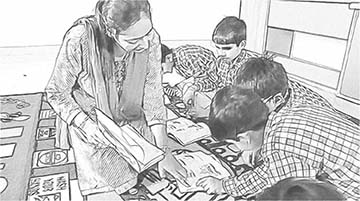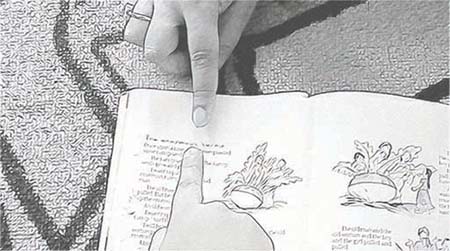4 Whole-class guided reading in groups
In guided reading, you organise the whole class into reading ability groups. Each group has individual books or reading cards, or a shared book geared to their reading level.

You spend time with each group, listening to individual students take turns to read aloud. As you work with each group, the other groups must be working independently.
- Have you ever done this, or seen this done?
- What do you think are the benefits of this method? What do you think the disadvantages of this method are?
- What do you need to know about your class in order to group them for reading?
Students will read at different speeds and finish at different times. When you set up students to read in groups, it is important to give them an additional task to do when they finish their reading, such as drawing pictures of characters, completing worksheets, writing a new ending to the story or designing a new cover for the book. This additional task can act as a reward and keep students motivated.
See Resource 2, ‘Using groupwork’.
Video: Using groupwork |

In the final case study, a teacher organises guided reading in a challenging situation.
Case Study 2: Mrs Jena manages guided reading groups
Mrs Jena teaches English to a multi-grade class with 46 Class IV–VI students, who are at different reading levels. She planned for a guided reading session for two periods of 80 minutes’ total duration.
Grouping and resources
First, I made students sit in six groups: five groups of eight and one group of six. I took the help of four students to organise the seating, calling out the name of each student and assigning a group to him or her. While assigning a student to each group, I was careful to ensure that students of similar reading ability were grouped together.
Students in one group could barely read any English, so I gave this group a big book of a Class I story. Students in two groups could read fairly fluently. To one of these groups I gave story books I had borrowed from the school library, and to the other group I gave a collection of simple stories I had been compiling from the children’s section of the newspaper. Students in two other groups were familiar with English letters and sounds, and could recognise a number of words, so I had them use reading cards with words and pictures and simple questions. I made these cards earlier in the year, with the help of the older students.
The six students in the last group required special help: one child was blind, one was dyslexic and four were migrant students who had joined the school only ten days earlier. I gave the blind student tactile letters that I had cut out from sandpaper, as was advised in training on inclusive education I attended in the summer. I told her to feel these letters and guess what they were, and that I would come back to help her. To the other five I gave a large picture book that my own son has now outgrown reading. I told this group to take turns to look at the picture book and talk quietly about what they could see in the pictures, and that I would come back to help them.
Monitoring and assessment
I planned to observe three groups of students: two of students struggling to read and one with fluent readers. Within the 80-minute double period, I also wanted to ensure that I spent time with all the groups of students.
Once the students settled in their groups, I spent about five minutes moving around from group to group, ensuring that they were all reading and had understood what was expected of them. Once I was satisfied they were settled, I spent 10–15 minutes with each group, listening to each student read a portion of the story, helping them where needed and asking them questions to gauge how much they had understood of what they had read. As I did this, I used a checklist I had prepared beforehand against each student and made very brief notes where necessary.
Classroom management
By the time I reached the third group, two students in another group had started quarrelling. Most students in the first group had finished reading what was assigned to them and were clamouring for my attention. For a moment, I felt flustered. I had planned to spend more time with the third group because they have been struggling to read, despite their best efforts. I had to act quickly. I separated the two students who were quarrelling and put them into different groups, telling them to help others and that I would be watching them to see if they could achieve this. I asked some of the students who had finished reading to make drawings in their notebooks, depicting the story. I asked two others to read aloud the picture book to the last group. Only then was I able to spend the next 20 minutes with the third group.
By this time, the noise level in the class had been steadily rising as students had either finished reading or become restless. I tried my counting strategy; my students know that when I start counting slowly up to five, they must settle back into their places and stop making noise. Only five minutes were left before it was lunch break. I quickly gave them a homework assignment of reading and copying the label of any three products they find in their house or neighbourhood shop. I called the last group of six students aside and asked them to draw any three products and write the first letter as their home assignment. I asked the blind student to ask her mother to name three products and for her to repeat them in the next class.
I made a note in my diary soon after the bell: to make time in the next class to work with students in the group who were given the library books, and the names of students whom I did not hear read that day.
Pause for thought Mrs Jena ran a very complex, multi-levelled set of classroom activities in a large class. There was a lot going on. Reflect on how your class is similar to or different from Mrs Jena’s. To finish this unit, answer the following questions about Mrs Jena’s techniques:
|
If you do not feel able to do everything that Mrs Jena did, we hope this unit has given you some ideas and encouragement to try out new routines and resources for reading English in your classroom.
3 Resources for reading silently
